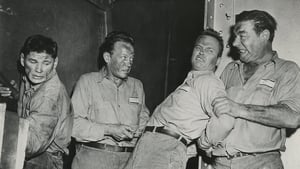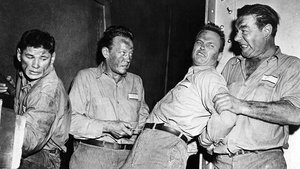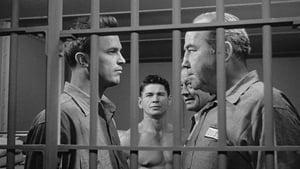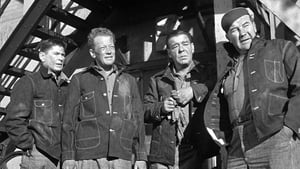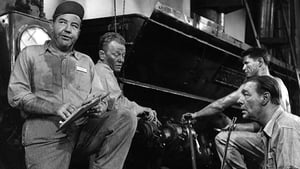Video Sources 0 Views
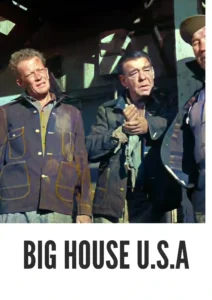
Synopsis

Delve into the dark and gritty world of mid-century crime with Big House, U.S.A., a compelling crime drama from 1955, meticulously colorized to immerse you in its stark reality. Starring Broderick Crawford and Ralph Meeker, this film offers a no-holds-barred look at the FBI’s pursuit of a ruthless kidnapping ring operating near a national park. Perfect for fans of classic crime stories and those fascinated by the evolution of law enforcement narratives, this HD download brings a forgotten gem of suspenseful cinema to life.
Big House, U.S.A. plunges viewers into the desperate aftermath of a kidnapping that rocks a small community. Jerry Mitchell, a young boy, is abducted while on a family vacation in Colorado. The FBI, led by Special Agent Banks (Broderick Crawford), launches an immediate and extensive investigation.
As the FBI closes in, they uncover a network of hardened criminals led by the chillingly cold-blooded Joe Baker (Ralph Meeker). Baker and his gang demand a hefty ransom, pushing the boy’s parents and the authorities to their breaking points. The investigation leads the FBI through a maze of deceit, violence, and moral compromise, exposing the dark underbelly of American society. The film culminates in a tense showdown as the FBI races against time to rescue Jerry and bring the kidnappers to justice, highlighting the dedication and sacrifices of those who protect the innocent. Big House, U.S.A. is a gripping narrative that explores themes of justice, desperation, and the resilience of the human spirit.
The film boasts a powerful cast that adds depth and authenticity to this intense crime story:
-
Broderick Crawford as Special Agent Banks
-
Ralph Meeker as Joe Baker
-
Reed Hadley as Congressman Thompson
-
William Talman as Kiefer
-
Lon Chaney Jr. as Alamo
Big House, U.S.A. firmly resides in the crime drama genre, with elements of suspense and thriller that keep audiences on the edge of their seats. Its focus on law enforcement procedures and the psychological impact of crime sets it apart as a compelling and thought-provoking film.
Released in 1955, Big House, U.S.A. reflects the post-war anxieties and the growing fascination with crime and law enforcement in American society. The film was produced during a period when the FBI was gaining prominence as a symbol of national security and justice. While Big House, U.S.A. may not be as celebrated as some of the era’s more famous crime dramas, it offers valuable insights into the social and cultural concerns of the time.
This colorized version of Big House, U.S.A. has been meticulously restored using state-of-the-art digital techniques, enriching the visual experience while respecting the film’s original tone and atmosphere. The colorization process involved a detailed analysis of the original black and white footage, with careful attention paid to accurately representing the settings, costumes, and characters. Advanced algorithms were used to select appropriate color palettes and enhance image quality, bringing a new level of vibrancy to the story. This painstaking process aims to introduce the film to a wider audience, ensuring its preservation and appreciation for generations to come.
-
: Howard W. Koch
-
: John C. Higgins
-
: John Martin
-
: Gordon Avil
-
: J. Robert Parrish
-
: United Artists
-
: United Artists
-
: 82 minutes
-
: MP4
-
: HD (1080p)
-
: Compatible with most devices, including smartphones, tablets, computers, and smart TVs.
Big House, U.S.A. (1955) is recognized for its gritty realism and its unflinching portrayal of crime and law enforcement. While it may not be as widely discussed as some of the era’s more iconic films, it remains a compelling and historically significant example of the crime drama genre. Its intense performances and suspenseful storyline continue to resonate with audiences today.
-
: What is Big House, U.S.A. about?
-
A: Big House, U.S.A. is a crime drama about an FBI investigation into a kidnapping ring operating near a national park.
-
-
: Is Big House, U.S.A. (1955) a well-known crime film?
-
A: While not as famous as some of its contemporaries, Big House, U.S.A. is a respected and historically significant example of the crime drama genre.
-
-
: Is this version of Big House, U.S.A. colorized?
-
A: Yes, this version has been professionally colorized to enhance the viewing experience.
-
-
: What makes Big House, U.S.A. interesting for crime film fans?
-
A: Big House, U.S.A. offers a realistic and suspenseful portrayal of crime and law enforcement in mid-century America.
-
-
: What is the download format?
-
A: The download format is MP4, which is compatible with most devices.
-
-
: What resolution is the download?
-
A: The resolution is HD (1080p), providing a high-quality viewing experience.
-
Watch Big House, U.S.A. Today!
